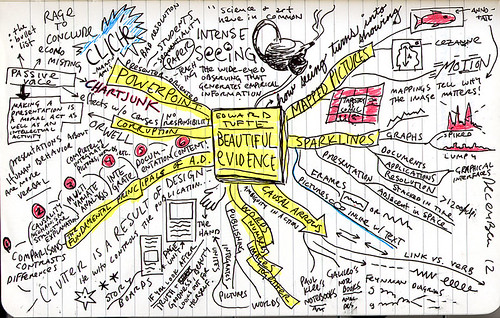done with sumi-e brush and markers. way bigger than my scanner, so i experimented with cleaning up the digital photo in photoshop (check out peter durand’s great post about this)
MORE MAPPING
Here’s another map I did with the ol’ sumi-e brush for an essay I’m working on. The piece of paper was really huge, so I had to take a photo with the digital camera. I had all this random junk floating around my head for the essay, but I couldn’t figure out how to put it in linear, narrative form. I started out thinking this would be another radial map (I started with the black box in the bottom-middle), but it ended up with a horizontal flow (what you see is only the top half of the sheet). This was a happy accident, and in the process of drawing the map, I realized the narrative that was hiding amongst all the random junk.
The quote by McCloud in the top, lefthand corner is from chapter 6 of UNDERSTANDING COMICS, “Show and Tell.” Notice the creative writing professor repeating the mantra of workshop: “Show, don’t tell!”
(I should note that even though I often take shots at creative writing workshops, my own workshop professor was wonderful: I took all my workshops at Miami from him, and he is still a good friend of mine. He’ll even be at the wedding!)
BEAUTIFUL EVIDENCE
“Science and art have in common intense seeing…” – Edward Tufte
This is a mind map I did while reading Edward Tufte’s new one, Beautiful Evidence. I’ve been interested in this kind of “radial” note-taking ever since I read about “clustering” in one of Janet Burroway’s books on fiction. Graphic facilitators (like the cartoonist Drew Dernavich) do glorified doodling like this for a living.
Beautiful Evidence is, like all of Tufte’s previous books, fantastic. I enjoyed the chapters on picture/word integration and PowerPoint the best. The great thing about Tufte is the primary sources he uses, and in this book, he quoted everything from Galileo’s Starry Messenger, to a guide to spotting a concealed handgun, to Martin Amis’s The War Against Cliche.
Tufte’s sources come from all disciplines: his books are the most inherently integrated and interdisciplinary I’ve ever read. He also draws from great literature. In his Envisioning Information, he quoted from Italo Calvino’s Six Memos For The Next Millenium, which I’ve been hot for all year:
My working method has more often than not involved the subtraction of weight. I have tried to remove weight, sometimes from people, sometimes from heavenly bodies, sometimes from cities; above all I have tried to remove weight from the structure of stories and from language….Maybe I was only then becoming aware of the weight, the inertia, the opacity of the world — qualities that stick to writing from the start, unless one finds some way of evading them.
In other news, I had my first wedding anxiety nightmare last night, so you know it’s getting close. (Meghan’s been having them for weeks now.)
THE POINT AT WHICH SAFE WATER BECOMES DANGEROUS WATER
My new hobby is drawing while watching TV. I drew these pages while watching Ken Burns’ documentary on Mark Twain.
Did you know that Mark Twain kept scrapbooks wherever he went? He even patented his own “self-pasting” scrapbook. It was the only invention of his that ever made any money.
After Mark Twain got married, he said, “I’m so happy I could scalp somebody.”
- ← Newer posts
- 1
- …
- 9
- 10
- 11




